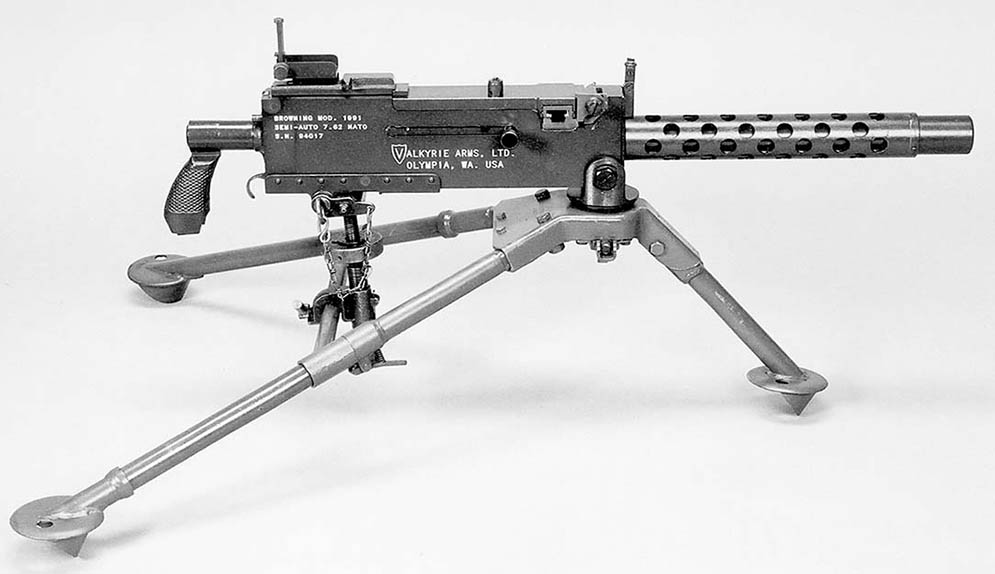
By Mark Genovese
I first became aware of Valkyrie Arms and the rather colorful owner Valerie Johnson through an ad in a 1995 issue of Machine Gun News. After an hour-long phone conversation, Val had answered all my questions gained my confidence and I placed an order. Despite all the negative press on the 1919A6 I myself always found the lines of the M-7 flash hider the GI bipod and shoulder stock very attractive and easy on the eye and these are the reasons I chose this model. The weapon was delivered in .308 caliber with a Hahn linking machine of St. Charles, MO for $4,150. Nowadays one can purchase a 1919A4 from a choice of at least seven different manufactures and many for under $2000.00. Back in 1996, there were only DLO of Arcadia, FL, TNW Inc. of Vernonia, OR and Valkyrie Arms of Olympia, WA. As you can see competition effectively lowered the price by half.
Valkyrie’s very unique approach to the problem of designing a disconnecting trigger lock is what really sold me on her product. Starting with a solid block of tool steel, it’s then machined down to the outside dimensions of the 1919 lock. There are three pivot pin holes (not including the accelerator pin hole) in different locations as opposed to the single pivot pin as on the full-auto lock. The forward pin holds a newly manufactured sear trip shaped like the letter J, the tip duplicating the full-auto trigger and functioning within an unaltered full-auto sear. The middle pin holds a AR-15 hammer (and return spring) that is modified by removing the notch and rounding the top of the hammer completely. This allows the bolt, when in recoil, to cock the modified hammer. The rear pin holds a modified AR-15 trigger and un-modified disconnector. The original AR-15 finger hold is removed from the bottom of the part and a new one added on the rear, replicating the full-auto trigger. The Valkyrie trigger lock does not utilize the full-auto-style spring-loaded trigger pin used to hold the assembly within the receiver. Next, the right hand side plate has an 1/8-inch-thick by 1-inch wide raised area that runs right in the middle of the side plate, front to rear. Be advised this raised, or thick portion, of the right-hand side plate cannot be welded or riveted on, it must start from a solid steel plate machined to the correct dimensions. By incorporating the so-called thick side plate you are now required to machine the right side of the bolt, barrel extension and trigger lock frame as well. This semiautomatic-only conversion also has an unusual bottom plate. Of the eight rivets per side, the fourth from the front on each side has a corresponding protruding raised tab inside the receiver requiring the bottom front of the lock frame to be machined out 1/2-inch wide by 11/4-inch long to allow the lock all the way in the receiver. These same protruding tabs do not allow the barrel extension to engage the breech lock cam that is mounted on the bottom plate. The manufacturer chose a rather novel solution for this problem, simply machining off the portion of the barrel extension that engages the breech lock cam. This seemingly cavalier approach in dealing with this engineering hurdle does not seem to affect the function whatsoever.
The rear of the right side plate top to bottom has been heat treated to USGI specifications. The engraving to the right side plate is of the highest standard, deeply cut and highlighted in white. The Parkerizing is perfect and the A6 parts are genuine USGI not Israeli knock offs.. Over the past six years I’ve had the opportunity to fire close to 25,000 surplus rounds through this fine weapon without one single parts failure. I had the barrel, barrel jacket, bearing and flash hider all hard chromed by Checkmate Custom of Brookville, FL because I shoot only corrosive ammunition and it makes clean up a lot easier. The boys over at Black Bear MFG of North Jackson, Ohio made me the slickest 16-inch barrel set up you have ever seen and the 3-foot flame and .50 caliber report really gets your attention.
I’ve heard a lot of talk about smooth fast shooting semi auto belt feds, I own six of them from four different manufacturers and I can say honestly that the Valkyrie 1919/AR15 system has the smoothest lightest trigger pull money can buy. Then there is the issue of how fast does this weapon shoot? I did a little informal experiment last year and linked up a 1,000-round continuous belt and then set up a PACT timer/chronograph. The average rate of fire was 650 rpm or about a 100 rpm faster than the full-auto!
| This article first appeared in Small Arms Review V6N7 (April 2003) |










